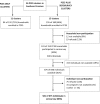Integrating Blood Collection within Household Surveys: Lessons Learned from Nesting a Measles and Rubella Serological Survey within a Post-Campaign Coverage Evaluation Survey in Southern Province, Zambia
- PMID: 30277204
- PMCID: PMC6283518
- DOI: 10.4269/ajtmh.18-0320
Integrating Blood Collection within Household Surveys: Lessons Learned from Nesting a Measles and Rubella Serological Survey within a Post-Campaign Coverage Evaluation Survey in Southern Province, Zambia
Abstract
Age-specific population immunity to many vaccine-preventable diseases can be measured using serological surveys. However, stand-alone serological surveys are infrequently conducted in low- and middle-income countries because of costs, operational challenges, and potential high refusal rates for blood collection. Nesting a serosurvey within a household cluster survey may overcome some of these challenges. We share lessons learned from nesting a serosurvey within a measles and rubella vaccination post-campaign coverage evaluation survey (PCES). In 15 of the 26 PCES clusters in Southern Province, Zambia, we collected dried blood spots from 581 participants aged 9 months and older. Household participation rates for the main PCES were higher in the serosurvey clusters (86%) than PCES-only clusters (71%), suggesting that a serosurvey can be successfully integrated without adversely affecting PCES participation. Among households that participated in the PCES, 80% also participated in the serosurvey and 86% of individuals available in the household provided a blood sample for the serosurvey. Substantial planning and coordination, additional staff training, and community mobilization were critical to the success of the serosurvey. Most challenges stemmed from using different data collecting tools and teams for the serosurvey and PCES. A more efficient design would be to fully integrate the serosurvey by adding blood collection and additional questions to the PCES.
Figures
Similar articles
-
Measles and rubella serosurvey identifies rubella immunity gap in young adults of childbearing age in Zambia: The added value of nesting a serological survey within a post-campaign coverage evaluation survey.Vaccine. 2019 Apr 17;37(17):2387-2393. doi: 10.1016/j.vaccine.2019.02.037. Epub 2019 Mar 21. Vaccine. 2019. PMID: 30905529 Free PMC article.
-
How much does it cost to measure immunity? A costing analysis of a measles and rubella serosurvey in southern Zambia.PLoS One. 2020 Oct 15;15(10):e0240734. doi: 10.1371/journal.pone.0240734. eCollection 2020. PLoS One. 2020. PMID: 33057405 Free PMC article.
-
Impact of a Measles and Rubella Vaccination Campaign on Seroprevalence in Southern Province, Zambia.Am J Trop Med Hyg. 2021 May 3;104(6):2229-2232. doi: 10.4269/ajtmh.20-1669. Am J Trop Med Hyg. 2021. PMID: 33939639 Free PMC article.
-
Measles and rubella microarray array patches to increase vaccination coverage and achieve measles and rubella elimination in Africa.Pan Afr Med J. 2020 Jan 3;35(Suppl 1):3. doi: 10.11604/pamj.supp.2020.35.1.19753. eCollection 2020. Pan Afr Med J. 2020. PMID: 32373254 Free PMC article. Review.
-
Problems in measles and rubella.Dis Mon. 1978 Mar;24(6):1-52. doi: 10.1016/s0011-5029(78)80004-2. Dis Mon. 1978. PMID: 401427 Review. No abstract available.
Cited by
-
Measles and rubella seroprevalence in adults using residual blood samples from health facilities and household serosurveys in Palghar District, Maharashtra, India, 2018 - 2019.Epidemiol Infect. 2024 Dec 6;152:e161. doi: 10.1017/S0950268824001389. Epidemiol Infect. 2024. PMID: 39639481 Free PMC article.
-
Who is missed in a community-based survey: Assessment and implications of biases due to incomplete sampling frame in a community-based serosurvey, Choma and Ndola Districts, Zambia, 2022.PLOS Glob Public Health. 2024 Apr 29;4(4):e0003072. doi: 10.1371/journal.pgph.0003072. eCollection 2024. PLOS Glob Public Health. 2024. PMID: 38683820 Free PMC article.
-
Measles and rubella serosurvey identifies rubella immunity gap in young adults of childbearing age in Zambia: The added value of nesting a serological survey within a post-campaign coverage evaluation survey.Vaccine. 2019 Apr 17;37(17):2387-2393. doi: 10.1016/j.vaccine.2019.02.037. Epub 2019 Mar 21. Vaccine. 2019. PMID: 30905529 Free PMC article.
-
Modeling the Cost of Vaccinating a Measles Zero-Dose Child in Zambia Using Three Vaccination Strategies.Am J Trop Med Hyg. 2024 May 21;111(1):121-128. doi: 10.4269/ajtmh.23-0412. Print 2024 Jul 3. Am J Trop Med Hyg. 2024. PMID: 38772386 Free PMC article.
-
Optimizing the implementation of a participant-collected, mail-based SARS-CoV-2 serological survey in university-affiliated populations: lessons learned and practical guidance.BMC Public Health. 2022 Oct 12;22(1):1907. doi: 10.1186/s12889-022-14234-1. BMC Public Health. 2022. PMID: 36224583 Free PMC article.
References
-
- Cutts FT, Hanson M, 2013. Seroepidemiology: an underused tool for designing and monitoring vaccination programmes in low‐and middle‐income countries. Trop Med Int Health 21: 1086–1098. - PubMed
-
- Nguipdop-Djomo P, Thomas S, Fine P, 2013. Correlates of Vaccine-Induced Protection: Methods and Implications Available at: http://researchonline.lshtm.ac.uk/2728969/. Accessed August 5, 2018.
MeSH terms
Substances
LinkOut - more resources
Full Text Sources
Medical



